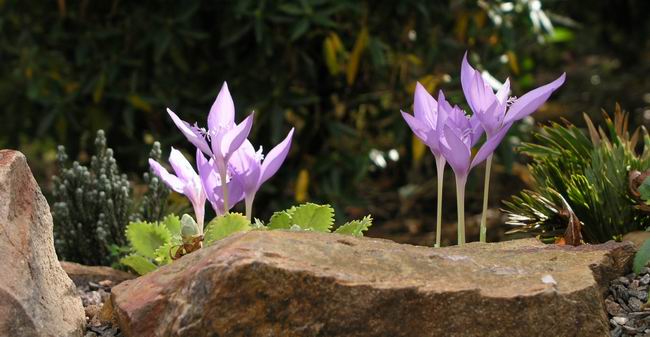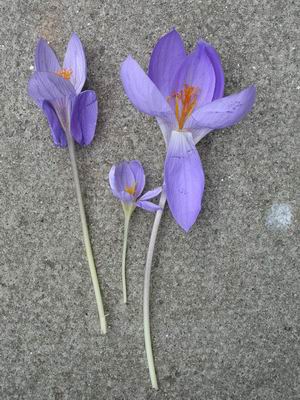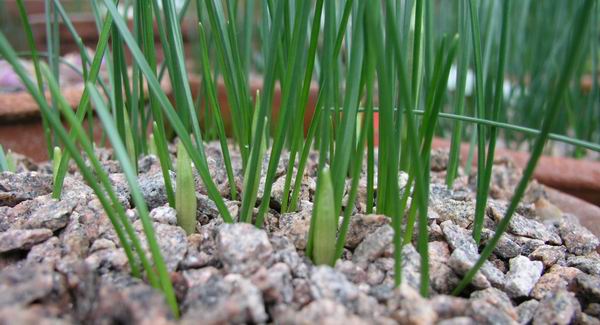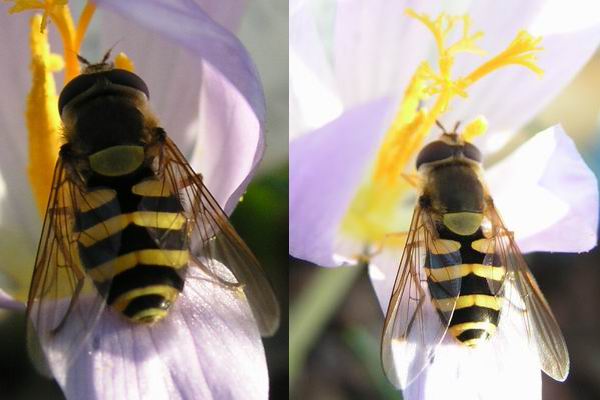 |
SRGC Bulb Log Diary |
| Home Recommend This Site To A Friend |
|
BULB LOG 43 23rd October 2003

Crocus banaticus in garden This is Crocus banaticus growing in the garden - they are paler and taller than the ones raised from Romanian seed that I showed in the last log. We always sow some of our own C. banaticus seed every year and have been selecting out the forms that appeal to us to grow on in pots. We are selecting the following characteristics, short, with large flowers where the petals, sepals and style have contrasting colours. The rest get planted around the garden like these ones which are still beautiful. 
Crocus banaticus 'Novaks White' We managed to get hold of a white form last year Crocus banaticus 'Novaks White' which we have been inter-pollinating with our other forms and we are hopeful of some interesting results. There is another very good white form of C. banaticus called 'Snowdrift' grown and shown by the Martins which I am lucky enough to have just got hold of. 
Crocus speciosus x3 I am returning to Crocus speciosus once more to illustrate the range of size that the flowers have. From the left we have C. speciosus 'Oxonian', the small one in the centre is C. speciosus ssp xantholaimos (raised from collected seed) and the huge flower on the right is 'Conqueror'. The two named forms we got some years ago from Broadleigh Gardens and they are both excellent plants, flowering every year without fail in troughs and raised beds without and cover or protection. 
Crocus medius Another good Autumn flowering Crocus for the garden is C. medius the contrast between the blue \ purple flower and the scarlet multi-branched style is a stunning combination. 
Sternbergia lutea We grow Sternbergia lutea in the bulb house as it needs the extra heat you get under glass to form flower buds in our cool climate. We have tried it in the garden but it just does not flower outside in Aberdeen. 
Crocus mathewi x2 A stunning Crocus in flower just now is the recently named Crocus mathewi, a close relative to C. asumaniae. It was discovered by the Crocus gurus Pasche and Kerndorff, who have introduced so many fine bulbs into cultivation, and named for Brian Mathew, author of the definitive work 'The Crocus' - a must for all bulb growers. 
Crocus asumaniae. A few logs back I showed the newly emerging shoot of Tropaeolum azureum (small picture centre) well I cut the top off it two weeks ago and as you can see that the side shoots have extended well. 
Tropaeolum azureum 3 The left of the two large pictures was taken three days before the one on the right and it illustrates the growth that these side shoots will make if you pinch out the top, this will give a much better plant with four stems instead of one producing many more flowers next spring.(Fortune favours the brave!) 
Aphids I found these leaf suckers on one of the grass weeds I was pulling from a bulb pot in an open frame this week and it served as a timely reminder to me that aphids are around all year and will become active in mild spells, especially under glass. So with all the tender new leaves appearing on the Narcissus and other bulbs it is time to spray against these insects. 
Spraying against aphids I use a combined systemic and contact chemical ( various types are available) and I have never had any damage caused to the bulbs by the various sprays that I use. An aphid attack on the other hand can have terrible consequences worst of which would be introducing a virus to your bulbs and for this there is no cure available to the gardener. 
Narcissus buds 20.10. It was while spraying that I noticed that some of the Narcissus have buds emerging. This is Narcissus 'Camoro' (a cross made by Henry Taylor between N. cantabricus monophyllus and N. romieuxii) the buds have never appeared this early before. I have to choose the time I spray carefully as not all the insects that visit the bulb houses are harmful 
Hover fly x2 This hover fly helps pollinate the plants and its larvae eat aphids. I spray early in the morning so that the chemical has a chance to dry before the insects start to move around. ^ back to the top ^ |